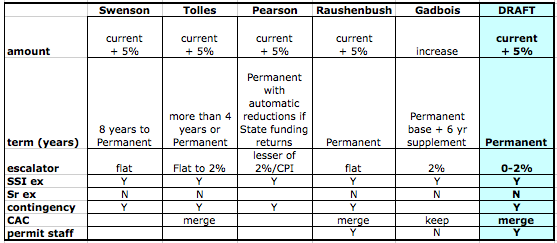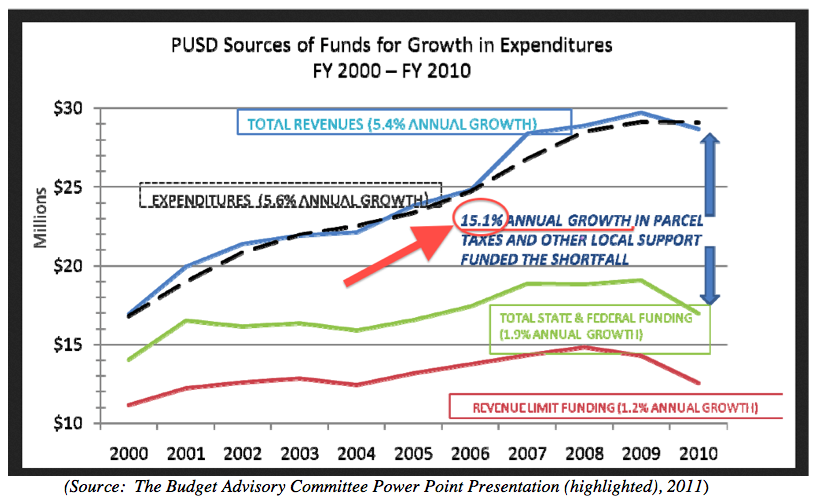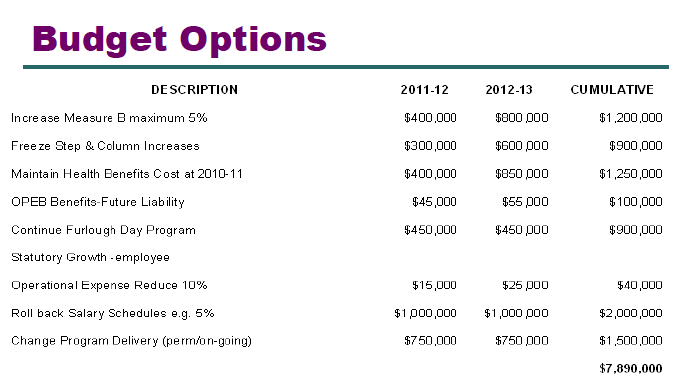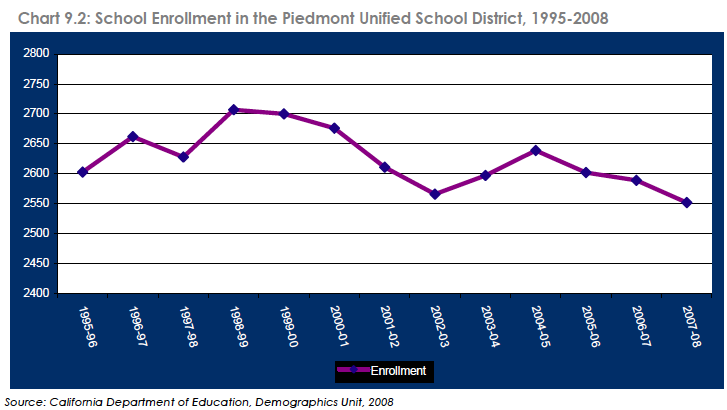And Abolishes Citizens Advisory Committee Independence –
At its meeting on Wednesday, October 24, the Piedmont School Board, in ongoing efforts to grapple with significant and ongoing budget shortfalls, directed School District staff to draft a tentative resolution to restructure Piedmont’s parcel tax as a permanent “evergreen” tax, possibly with an annual escalator of 2%. The Board also directed staff to draft a resolution to abolish the Citizens’ Advisory Committee (CAC) as an independent oversight entity, and to prepare an additional “flat tax” proposal in case Proposition 30 fails to win a majority vote in the Nov. 6 election.
The Board requested public input before its next November 14 meeting when the two draft resolutions will be presented. President of the Board, Rick Raushenbush, noted that public input on the alternative tax structures has been “all over the map.” Click here to send email all School Board Members
Draft Resolutions to be discussed Nov. 14
- PERMANENT TAX of $2,088 – $3,547 per parcel
- 0% to 2% ANNUAL ESCALATOR (to be decided by Board on Nov. 14)
- no increased written or public notice to taxpayers of proposed increases
- continue existing notice
at two publicSchool Board hearings prior to increases
- LOW INCOME EXEMPTION based on SSI Income limits
RESTRUCTURE INDEPENDENT CITIZENS’ ADVISORY COMMITTEE (CAC)
- Convert to subcommittee of the Budget Advisory Committee (rather than independent oversight committee)
- Members appointed by President and Vice President (rather than Board)
- Limit to 3-5 members (rather than at least 7)
- Past District staff permitted to serve on CAC subcommittee (if resident of Piedmont)
- POSSIBLE ADDITIONAL EMERGENCY
TAX
- Flat $275 per parcel for 4 years
A Major Restructuring of Piedmont School Parcel Tax
The proposed draft will provide for a permanent tax, eliminating city-wide votes held every 4 years to determine the amount of the tax. Board members Raushenbush, Andrea Swenson, and Roy Tolles strongly urged a flat tax with no escalator because the District will be asking voters to approve a permanent (“evergreen”) tax. Other members were willing to support an escalator of “up to 2% increases” annually to allow for inflation and mirror the Proposition 13 limit on other property taxes. Limiting the escalator to “the lesser of” 2% or the CPI was also mentioned.
Raushenbush noted that he had received a call from former School Board President June Monach, who reminded him of the District goal of reducing the parcel tax as a percentage of the school budget. If state funding continues to be flat, an escalator will result in local taxpayer support increasing above the current 33% of the District’s budget.
The level of the permanent tax would be the current Measure B tax, plus an anticipated 5% increase in June 2013, for a total amount of $2,088 – $3,547 per parcel. (The discretionary 5% increase, previously authorized by the 2009 Measure B, will be voted on by the Board in March 2013.) The restructured Measure B would become effective on July 1, 2014 when the current 4-year measure expires.
No enhanced notice of increases
While some Board members expressed a desire for greater accountability through annual public forums, polls, surveys, or other options, the Board, via its President, directed staff not to change current notice requirements for annual tax increases. If an escalator is ultimately included, the draft resolution will permit tax increases to be levied annually without specific prior written notice to taxpayers. As under the Current Measure B, two public School Board hearings would be required prior to any increases. Annual increases levied by the School Board would be discretionary and not automatic. However, the Board has imposed the maximum allowed increase each time prior measures authorized an increase.
Citizens’ Advisory Committee loses independence
The Board President directed staff to abolish the separate independent structure of the Citizens’ Advisory Committee (CAC) oversight, despite some members noting it had provided “valuable input” to the Board. The draft proposal will restructure the CAC as a small 4-5 member sub-committee of the Budget Advisory Committee (BAC).
This change has additional impacts. Members of the CAC subcommittee are appointed by the Superintendent, rather than the Board. Persons previously on the District staff will be permitted to serve on the CAC if they are a Piedmont resident. Currently, district staff serve on the BAC, while the CAC consists of Piedmont residents, enabling resident input with no conflicts of interest when advising the Board on parcel tax levies.
The Citizens Advisory Committee (CAC) was mandated by the 2009 parcel tax measures and established as an independent Board-appointed committee. The Committee is charged with “conducting an independent examination of the District’s budget“. (See, as an example, the 2012 CAC report.) It prepares an annual comprehensive report with recommendations on the appropriate parcel tax levy amount and:
“a high level, comprehensive analysis of the District’s budget, including relevant metrics, historical trends, and comparisons with similar school districts, that provides an analytical basis for the Committee’s recommendations.”
While the Budget Advisory Committee has traditionally been allowed to make recommendations to the School Board on the budget, the extent to which the CAC could analyze and make recommendations on program and personnel costs was challenged by district personnel. In response to these concerns, the School Board previously clarified the CAC’s charge and limited its ability to analyze district costs and make recommendations to the Board.
BAC members, who are selected by the Superintendent, are not listed on the PUSD website or the Piedmont Portal and not generally made publicly available. The PUSD website describes the BAC as “representatives from each school site, employee associations (APT for teachers and CSEA for classified staff), administration, support groups, the community at-large, and the Board of Education. Members serve for one to two years.” The number of voting members is not specified, nor the number of votes required to make a recommendation to the Board. Minutes of the meetings are not posted online. However, the Superintendent has noted the BAC is subject to notice and other “sunshine” provisions of the state Brown Act and that the district complies with the Brown Act. In September, the Superintendent indicated that, in contrast to past practice, a person from each representative group has not necessarily been appointed to the BAC in recent years.
An “SSI” Low-Income Exemption
A “senior” exemption to the school parcel tax based on age will not be included in the draft resolution. However, an exemption based on meeting the income limitations for Supplemental Security Income (SSI) will be included. This provision was supported by 4 Board members. Eligibility would be established by the taxpayer’s annual “SSI Award” letter from the local Social Security office, rather than determined by the Piedmont Unified School District. In 2012, SSI was limited to those with less than $1,010 of gross monthly income. Earned, unearned, in-kind, social security, and deemed income, as well as assets, are considered, making it unlikely that many Piedmont residents, even seniors on fixed incomes, would qualify.
Additional 4 Year Flat Tax Possible if Proposition 30 Fails
The Board also directed staff to prepare a second parcel tax resolution for an emergency tax. If Proposition 30 fails in the November 6 election, the Board may ask voters to approve this additional funding before reducing costs. The emergency tax would be a flat, annual $275 per parcel for 4 years. (In contrast, the prior “one-time emergency” Measure E was a 3-year tax of $249 per year.) A “SSI” exemption would be included.
The $275 tax will generate $1.5 million, designed to match the automatic one-time 2012 trigger cuts of $1.5 million which will occur if Proposition 30 fails. However, the new temporary measure is proposed for a term of 4 years, not 1 year.
According to Hubbard, contract negotiations with employee unions will be opened the day after the vote on Proposition 30 (Nov. 7, 2012) in an effort to eliminate a $1.2 million shortfall in Piedmont’s 3 year budget plan, restore a state mandated reserve of 3% (almost $1 million), and if Proposition 30 fails, address an additional $1.5 million shortfall, for a total potential $3.5 million deficit. District is currently borrowing and repaying funds from the School Bond Fund to cover cash flow issues. School Superintendent Constance Hubbard previously identified $4 million in ongoing District operating cost reductions which have not been implemented.
The District engaged an outside consultant to conduct telephone interviews with 200 residents selected “from all areas of Piedmont.” Parents and non-parents were included, though the ratio of parents to non-parents was not reported. The full results of the survey were not reported in writing. Staff indicated residents were asked if they “supported” various aspects of the District program (e.g. teacher development) without specific cost information, and asked about possible tax structures.
On November 14, the School Board will review the draft language of the two tax resolutions and determine whether or not to impose an escalator of up to 2%, rather than proposing a flat tax. The Board will continue to take public comment on the draft resolutions. However, staff has indicated there will not be sufficient time to make major revisions and still meet deadlines to place them on the March 2013 ballot. The Board continues to ask for public input prior to their final approval. Comments may be sent to the Board members at their email addresses. (See below.)
- Richard (Rick) Raushenbush President rraushenbush@piedmont.k12.ca.us
- Andrea Swenson Vice President aswenson@piedmont.k12.ca.us
- Sarah Pearson spearson@piedmont.k12.ca.us,
- Ray Gadbois rgadbois@piedmont.k12.ca.us
- Roy Tolles rtolles@piedmont.k12.ca.us
- (may also cc Superintendent Constance Hubbard) chubbard@piedmont.k12.ca.us







